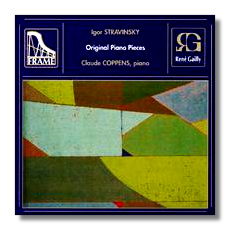
The Internet's Premier Classical Music Source
Related Links
- Stravinsky Reviews
- Latest Reviews
- More Reviews
-
By Composer
-
Collections
DVD & Blu-ray
Books
Concert Reviews
Articles/Interviews
Software
Audio
Search Amazon
Recommended Links
Site News
 CD Review
CD Review
Igor Stravinsky

Piano Music
- Scherzo
- Four Studies, Op. 7
- Souvenir d'une marche boche
- Valse pour les enfants
- Piano-Rag-Music
- Les cinq doigts
- 8 Easy Pieces
- Sonata (1924)
- Serenade
- Tango
Claude Coppens, piano
Rene Gailly 87079 - 54min
How do you interpret a composer who claimed he never wanted to be interpreted? Obviously, you can't take his remarks at face value. At the reductio ad absurdum, there would be no reason to buy Stravinsky's CD of Le Sacre over any of Boulez's and vice versa. Perhaps the anti-interpretation police could listen attentively for signs of "personality." In my opinion, too many performers have allowed Stravinsky the polemicist to intimidate them to the extent that not only does the performer becomes faceless, the music does as well. A performer can accomplish a trick like this through real mental and physical effort. There's a hesitant, walking-on-eggshells quality to the playing and each note seems separate from its fellows.
Coppens falls into this trap time and again, even in the early works. There's little nuance or line either the Scherzo or the Four Studies. The Scherzo in particular comes off as nothing more than rhythmic slight-of-hand. The Four Studies should sing like Rachmaninoff or Tchaikovsky. Instead, practically everything is at the same, loud dynamic. I've got to credit Coppens's fingers, however, especially in the flashy, digit-busting fourth étude. Coppens lets go here with a rousing account. He even crescendos and decrescendos, proving he can do it. Why this doesn't happen in the other studies baffles me; they are merely played, rather than shaped.
The approach better suits the music just after World War I, and Coppens gives us a strong, witty account of the Piano-Rag-Music. He allows us to see how much other European dabblers in jazz – Milhaud, Antheil, and Martinů, for example – owed to Stravinsky's take on music which, at that time, he knew only from score and hadn't actually heard. The 8 Easy Pieces (not to be confused with the sets of Easy Pieces for two pianos) also appear in a performance very sensitive to Stravinsky's exploration of new, stripped-down piano sonorities. He meets the demands of the percussive music and of the tender music as well. These two works represent for me the high points of the disc.
The major works on the disc – the Sonata and the Serenade – fare inconsistently. The first movement of the Sonata should bound forward like a lamb in Spring. By keeping his notes too distinct, Coppens robs the movement of its momentum. The second movement – a stately aria in obvious homage to Bach and some of Stravinsky's greatest slow music – is tromped through: again, too much staccato. Worse, it comes off as eccentric, which means it doesn't convince. Stravinsky sang in his own way, but he still sang. Coppens repeats the gaucheries of the first movement in the finale – no momentum; the music lies there like windup chattering teeth – and commits new ones, including failure to separate the various contrapuntal strands.
The Serenade – my favorite of Stravinsky's original solo piano music – opens with real majesty and raised my hopes, which continued through the opening notes of the second-movement "Romanza." But the quick notes and the aria again killed off any life. I should make it clear that I'm not asking for Chopinesque suavity and swoons. Stravinsky's music very seldom melts the heart and its feelings, though deep, aren't all that overt. Nevertheless, the music does have feeling. Stravinsky was one of the 20th century's great tryers-on of masks: Bach, Handel, Tchaikovsky, Grieg, Pergolesi, Mozart, jazz and vernacular musics, among others. One reason to wear a mask is to hide feeling, but that means that the masker feels very strongly indeed. The "Cadenza finale" should come off as a profound close and, at the same time, a berceuse, but Coppens is so busy being "objective," that he merely plays the notes and the work ends flat.
The recorded sound is fine, suggesting a room rather than a concert hall. Stravinsky's music, however, has been better served.
Copyright © 1996, Steve Schwartz
















